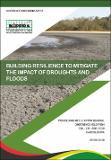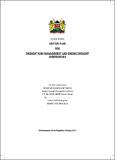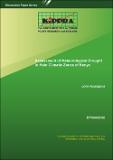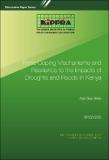| dc.date.accessioned | 2021-02-04T07:32:16Z | |
| dc.date.available | 2021-02-04T07:32:16Z | |
| dc.date.issued | 2018 | |
| dc.identifier.uri | http://repository.kippra.or.ke/handle/123456789/2616 | |
| dc.description | The Conference proceedings of the KIPPRA Regional Conference held from 5th – 7th June 2018, in Nairobi, Kenya. | |
| dc.description.abstract | Kenya’s geography makes it highly vulnerable to climate-induced hazards, namely droughts and floods. This is because over 80 per cent of the country is arid and semi-arid lands which receive erratic rains, and drought is a common defining feature. Given the fragility of the country’s environment and soils, whenever it rains, the run-off causes floods with downstream communities living on flood prone areas bearing the brunt of the effects. Indeed, we have a long history of these hazards, with major droughts recorded in 1975, 1983, 1999-2001 and 2016-2017. Flood episodes define Kenya’s pre-independence, with the 1961 flooding (commonly known as Uhuru floods) being the most intense to date. Other flood events in the county include the El Nino-related floods of 1997/98, that of 2003 and the 2018 floods that affected various parts of the county. | en |
| dc.language.iso | en | en |
| dc.publisher | The Kenya Institute for Public Policy Research and Analysis (KIPPRA) | en |
| dc.relation.ispartofseries | Conference Proceedings;2018 | |
| dc.subject | Drought Management | en |
| dc.subject | Natural Disasters | en |
| dc.subject | Disaster Management | en |
| dc.subject | Floods and Droughts | en |
| dc.subject | Semi Arid Areas | en |
| dc.title | Conference Proceeding No. 08 of 2018 on Building Resilience to Mitigate the Impact of Droughts and Floods | en |
| dc.type | KIPPRA Publications | en |
| ppr.contributor.author | Kenya Institute for Public Policy Research and Analysis (KIPPRA) | en |




